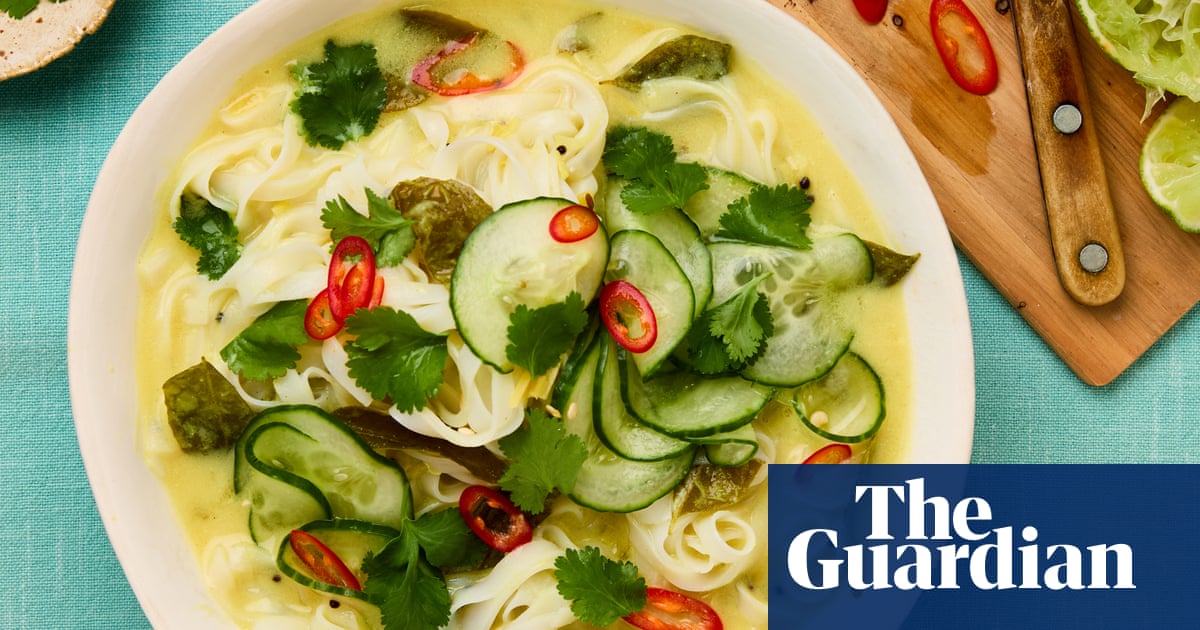When the thought of eating hot meals seems unbearable, chilled soups will help you beat the heat. Today’s ones are cooling, nourishing, hydrating and a little more fortifying than the usual chop-and-blitz raw soups such as gazpacho. As much as I love those, sometimes I want something I can get my teeth into; something with the satisfying chew of cold noodles, or a crunchy or herbaceous topping. These are perfect for dining al fresco, or to pour into jars and take along to a picnic.
This silky soup (pictured top), thickened with gram flour, gets its mellowness from sweet, comforting coconut yoghurt.
Prep15 minCook50 minChill4 hr+Serves4
350g natural coconut yoghurt30g chickpea flour½tsp turmeric1tbsp coconut oil1tsp brown mustard seeds1 pinch of asafoetida(optional)15 fresh curry leaves4 makrut lime leaves, stems removed and discarded, leaves torn½tsp cumin seeds1 stick cinnamon, broken up1 thumb of ginger, peeled and grated2 sticks lemongrass, white parts only, finely chopped1 green chilli, finely chopped, seeds and all1 heapedtsp soft brown sugarSea salt1 cucumber, very thinly sliced250g flat, wide rice noodlesJuice of 2 limes1 long red chilli, sliced on the diagonal, seeds and allFresh corianderleaves, to garnish
Whisk the yoghurt, chickpea flour and turmeric in a large bowl until smooth, then gradually beat in one and a half litres of water until there are no lumps.
Heat the coconut oil in a large saucepan and, once hot, sprinkle in the mustard seeds. As soon as they pop, add the asafoetida, curry leaves and lime leaves and, once they are in turn crackling, follow with the cumin seeds and cinnamon. Saute briefly, then add the ginger, lemongrass and chillies, and cook, stirring, until fragrant. Pour in the yoghurt mix, add the sugar and season with sea salt.
Cook, stirring constantly, on a medium heat until the mix comes to a boil, then turn the heat to low and simmer gently for 15-20 minutes. Take off the heat, leave to cool, then cover and chill in the fridge for at least four hours, until very cold.
Meanwhile, sprinkle the cucumber slices with a teaspoon sea salt, leave for 15 minutes, then rinse, drain and squeeze out any excess water.
Soak the noodles in boiling water for five minutes (or cook them according to the packet instructions), then drain, place in ice-cold water and drain again.
Divide the noodles between four bowls. Add the lime juice to the broth and mix – if it’s too thick, add a splash of water to loosen. Ladle the broth over the noodles, scatter over the cucumber, chilli and coriander, and serve.
This verdant soup made with sweet peas gets a spiky kick of flavour from the convenience of a ready-made curry paste, while fresh Thai basil adds vibrancy.
Prep5 minCook30 minChill4 hr+Serves4
1tbsp coconut oil1 bunchspring onions, trimmed and finely chopped2tbsp green Thai curry paste– I use Mae Ploy500g podded fresh peas, or frozen and defrosted peas400g hot vegetable stock400ml coconut milk1 large handful Thai basil50g spinachJuice of1 juicy limeAsian microgreensor pea shoots, to garnish
Melt the coconut oil in a large saucepan on a medium heat, then saute the spring onions until softened. Add the curry paste and saute, stirring, for five minutes until fragrant, then stir in the peas and pour over the stock. Reserve four tablespoons of the coconut milk, then tip the rest into the pan and simmer for five minutes.
Roughly chop the Thai basil and spinach, then add to the pan and simmer for five minutes. Take off the heat and blitz smooth using a stick blender or food processor. Leave to cool, then cover and chill in the fridge for at least four hours.
Before serving, squeeze in the lime juice, then divide between four bowls, drizzle over the reserved coconut milk and garnish with microgreens or pea shoots.
Be warned, this peanut furikake is highly addictive – you’ll want to sprinkle it over just about everything.
Prep15 minCook1 hrChill4 hr+Serves4
For the peanut furikake1tbspcoconut oil50g salted roasted peanuts, roughly chopped15 curry leaves,torn25g unsweetened desiccated coconut3tbsp sesame seeds1tsp nigella seeds1tsp brown mustard seeds2 nori sheets,crumbled and toasted1tbsp pure maple syrup¾tsp chilli powder½tsp sea salt
For the rasam5 medium tomatoes, finely chopped1bananashallot,peeled and finely chopped100g tamarind paste25g light brown soft sugar2 tbsp coconut oil or ghee1 tsp mustard seeds¼ tsp asafoetida(optional)15 fresh curry leaves1 star anise1 tsp cumin seeds2 green chillies, finely chopped, seeds and all30g piece fresh ginger, peeled and finely grated1 tsp ground coriander¾ tsp coarsely ground black pepper1 tsp ground turmeric
To make the furikake, melt the coconut oil in a frying pan, then add the peanuts, curry leaves, coconut, sesame seeds, nigella seeds and mustard seeds, and fry over a low heat for about five minutes, until golden brown and toasty. Add all the remaining furikake ingredients, stir briefly for 30 seconds, then spread over a baking sheet and leave to cool completely.
Now for the rasam. Put the tomatoes, shallot, tamarind and sugar in a large saucepan with a litre and a half of water. Bring to a boil, then turn down the heat and simmer for 30 minutes, until the tomatoes and shallot have broken down.
Meanwhile, melt the coconut oil or ghee in a frying pan on a medium-low heat, then add the mustard seeds. Once they pop, add the asafoetida, if using, curry leaves, star anise and cumin, and fry, stirring, for a minute. Add the chillies and ginger, and fry for about two or three minutes, until fragrant. Sprinkle in the ground coriander, pepper and turmeric, fry for 30 seconds, then pour into the tomato broth and leave to bubble gently over a low heat for a further 15 minutes.
Take off the heat, leave to cool, then cover and chill in the fridge for four to six hours, until cold. Ladle into bowls and serve sprinkled with the furikake.
